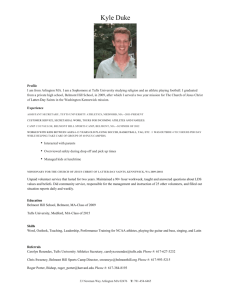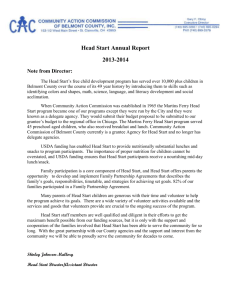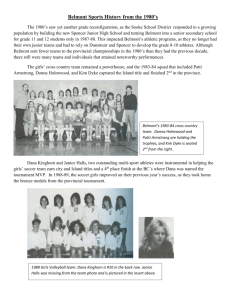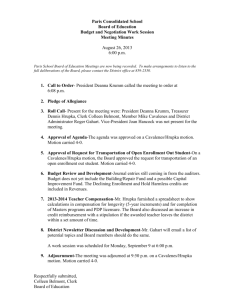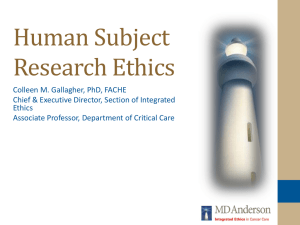Belmont & Fishtown
advertisement
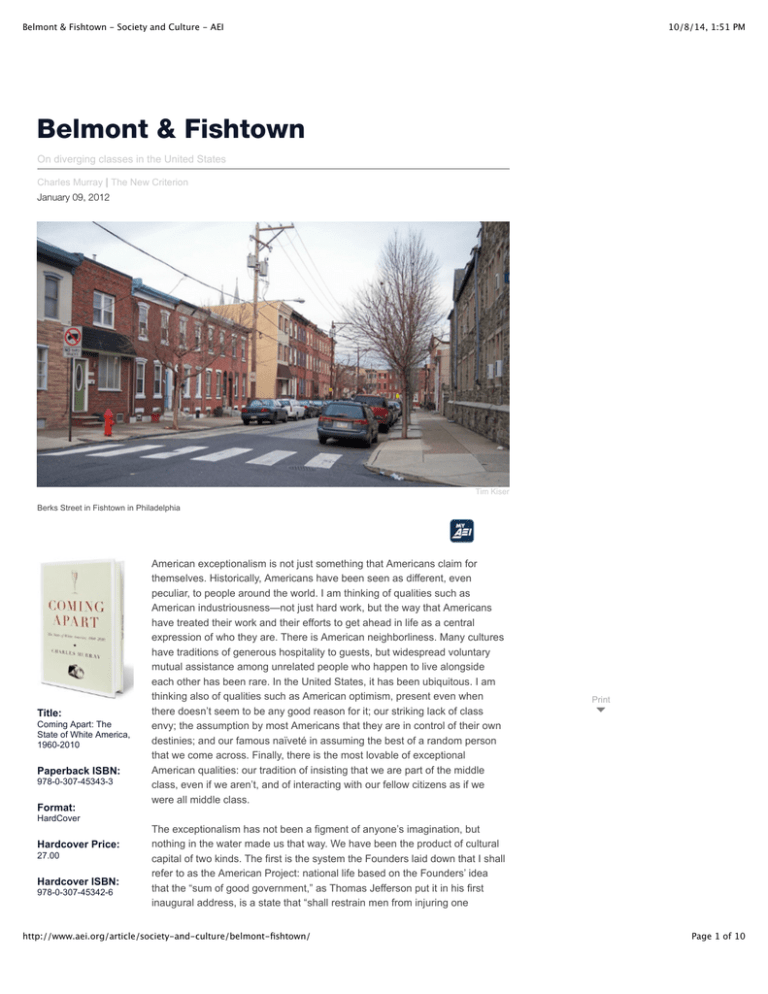
Belmont & Fishtown - Society and Culture - AEI 10/8/14, 1:51 PM Belmont & Fishtown On diverging classes in the United States Charles Murray | The New Criterion January 09, 2012 Tim Kiser Berks Street in Fishtown in Philadelphia Title: Coming Apart: The State of White America, 1960-2010 Paperback ISBN: 978-0-307-45343-3 Format: HardCover Hardcover Price: 27.00 Hardcover ISBN: 978-0-307-45342-6 American exceptionalism is not just something that Americans claim for themselves. Historically, Americans have been seen as different, even peculiar, to people around the world. I am thinking of qualities such as American industriousness—not just hard work, but the way that Americans have treated their work and their efforts to get ahead in life as a central expression of who they are. There is American neighborliness. Many cultures have traditions of generous hospitality to guests, but widespread voluntary mutual assistance among unrelated people who happen to live alongside each other has been rare. In the United States, it has been ubiquitous. I am thinking also of qualities such as American optimism, present even when there doesn’t seem to be any good reason for it; our striking lack of class envy; the assumption by most Americans that they are in control of their own destinies; and our famous naïveté in assuming the best of a random person that we come across. Finally, there is the most lovable of exceptional American qualities: our tradition of insisting that we are part of the middle class, even if we aren’t, and of interacting with our fellow citizens as if we were all middle class. Print The exceptionalism has not been a figment of anyone’s imagination, but nothing in the water made us that way. We have been the product of cultural capital of two kinds. The first is the system the Founders laid down that I shall refer to as the American Project: national life based on the Founders’ idea that the “sum of good government,” as Thomas Jefferson put it in his first inaugural address, is a state that “shall restrain men from injuring one http://www.aei.org/article/society-and-culture/belmont-fishtown/ Page 1 of 10 Belmont & Fishtown - Society and Culture - AEI Buy the Book Article Highlights Americans have formed a new lower class and a new upper class that have no precedent in our history @charlesmurray Tweet This The problem isn't the lifestyle of the new upper class but the degree to which it’s sealed off from the rest of America Tweet This Upper middle class, new middle class will no longer have any resemblance of what used to be the American Way of Life Tweet This 10/8/14, 1:51 PM another [and] shall leave them otherwise free to regulate their own pursuits of industry and improvement.” The second source of cultural capital has been a set of qualities about Americans that made the American Project feasible. Tocqueville’s disquisitions on these qualities are better known, but another early European observer of America, Francis Grund, summed it up nicely in his book The Americans in Their Moral, Social, and Political Relations (1837): The American Constitution is remarkable for its simplicity; but it can only suffice a people habitually correct in their actions, and would be utterly inadequate to the wants of a different nation. Change the domestic habits of the Americans, their religious devotion, and their high respect for morality, and it will not be necessary to change a single letter of the Constitution in order to vary the whole form of their government. The American Constitution is remarkable for its simplicity; but it can only suffice a people habitually correct in their actions, and would be utterly inadequate to the wants of a different nation. Change the domestic habits of the Americans, their religious devotion, and their high respect for morality, and it will not be necessary to change a single letter of the Constitution in order to vary the whole form of their government. As recently as half a century ago, Americans across all classes showed only minor differences on the Founding virtues. When Americans resisted the idea of being thought part of an upper class or lower class, they were responding to a reality: there really was such a thing as a civic culture that embraced all of them. Today, that is no longer true. Americans have formed a new lower class and a new upper class that have no precedent in our history. American exceptionalism is deteriorating in tandem with this development. America has never been a classless society. From the beginning, rich and poor have usually lived in different parts of town, gone to different churches, and had somewhat different manners and mores. It is not the existence of classes that is new, but the emergence of classes that diverge on core behaviors and values—classes that barely recognize their underlying American kinship. How Thick Is Your Bubble? 20 Questions This quiz is inspired by American Enterprise Institute scholar Charles Murray's new book, "Coming Apart: The State of White America, 1960-2010," which explores the unprecedented, class-based cultural gap in America. How culturally isolated are you? Answer these 20 questions to find out. Start Embed Embed & Share This Quiz Close X <iframe name='proprofs' id='proprofs' height='192' width='500' frameborder=0 marginwidth=0 marginheight=0 src='http://www.proprofs.com/quizschool/widget/v3/? id=320064&bgcolor=f5f5f5&fcolor=0e1527&tcolor=2 d3c59&w=480&h=45&ff=3&fs=large&pplink=0&embe To make this case, I use data based exclusively on non-Latino whites http://www.aei.org/article/society-and-culture/belmont-fishtown/ Page 2 of 10 Belmont & Fishtown - Society and Culture - AEI 10/8/14, 1:51 PM (hereafter just “whites”) as a way of focusing attention on the nature of the problem. We are not dealing with problems caused by ethnic inequalities. I also focus on people ages 30–49, adults in the prime of life, to strip away complications associated with young adults who are delaying marriage and older adults who are retiring earlier than they used to. To represent the classes at the two ends of the continuum, I give you two fictional neighborhoods that I hereby label Belmont (after an archetypal upper-middle-class suburb near Boston) and Fishtown (after a neighborhood in Philadelphia that has been white working class since the Revolution). To be assigned to Belmont, the people in my databases must have at least a bachelor’s degree and work as a manager, physician, attorney, engineer, architect, scientist, college professor, or in content-production jobs in the media. To be assigned to Fishtown, they must have no academic degree higher than a high school diploma. If they work, their job must be in a bluecollar, service, or low-level white-collar occupation. Here’s what happened to the Founding virtues in Belmont and Fishtown from 1960 to 2010: Marriage. "Americans have formed a new lower class and a new upper class that have no precedent in our history. American exceptionalism is deteriorating in tandem with this development." In 1960, extremely high proportions of whites ages 30–49 in both Belmont and Fishtown were married—94 percent in Belmont and 84 percent in Fishtown. The unquestioned norm in both neighborhoods was marriage. In the 1970s, those percentages declined about equally in Belmont and Fishtown. Then came the great divergence. In Belmont, marriage among prime-age adults stabilized during the mid-1980s and remained flat thereafter, standing at 83 percent in 2010. In Fishtown, marriage continued a slide that had not slackened as of 2010, when the percentage of married whites ages 30–49 had fallen to a minority of 48 percent. What had been a 10 percentage point difference between Belmont and Fishtown in the 1960s stood at 35 percentage points in 2010. The culprits— divorce and failure to marry in the first place —split responsibility for the divergence about equally. --Charles Murray Another aspect of marriage showed just as great a divergence: the percentage of children born to unmarried women. Frightened though politicians and media eminences are to say so, nonmarital births are problematic. Children who are born to unmarried women fare worse than the children of divorce and far worse than children raised in intact families even after controlling for the income and education of the parents. The technical literature on that topic is large and damning. The literature on what happens when large proportions of children within a neighborhood are born to unmarried women is less extensive, but the coincidence between that phenomenon and communities that have fallen apart, whether they be in the inner city or rural America, suggests that a large proportion of nonmarital births within a community constitutes a social catastrophe. http://www.aei.org/article/society-and-culture/belmont-fishtown/ Page 3 of 10 Belmont & Fishtown - Society and Culture - AEI 10/8/14, 1:51 PM In 1960, just 2 percent of all white births were nonmarital. When the Vital Statistics first gave us the mother’s education in 1970, 6 percent of births to white women with no more than a high school education—women with a Fishtown education—were out of wedlock. Or to put it another way, 94 percent of such births were within marriage. By 2008, 44 percent were nonmarital. Among the college-educated women of Belmont, less than 6 percent of all births were out of wedlock as of 2008, up from 1 percent in 1970. Industriousness. The norms for work and women were revolutionized after 1960, but the norm for men putatively has remained the same: Healthy men in the prime of life are supposed to work. In practice, that norm has eroded everywhere. In Fishtown, the change has been drastic. To avoid conflating this phenomenon with the current recession, I use data collected in March 2008, before the onset of the recession, as the end point for the trends. The primary indicator of the erosion of industriousness is the increase of prime-age males with no more than a high school education who say they are not available for work—they are “out of the labor force,” in the jargon. That percentage went from a low of 3 percent in 1968 to 12 percent in 2008, rising steadily during the boom years of the 1980s and 1990s when the labor market had plentiful bluecollar jobs available for anyone who wanted to work. Even those who had jobs worked less—in 1960, only 10 percent of employed Fishtown males worked fewer than 40 hours per week. By 2008, that percentage had doubled. In Belmont, the percentage working fewer than 40 hours per week went from 9 to 12. Again it needs to emphasized: These reductions in work hours occurred in years when men could find work for as many hours as they wanted to work. Honesty. I focus on honesty as reflected in crime rates. Another aspect of honesty— integrity in matters not governed by criminal law—is just as important to America’s civic culture, but I could not find trends grounded in large-sample, interpretable data. Ever since criminology became a discipline, scholars have found that criminals are overwhelmingly drawn from working-class and lower-class neighborhoods—Fishtown. But in 1960, crime was low and the existing differences between Belmont and Fishtown did not impinge on daily life. The real Fishtown in Philadelphia, for example, was an extremely safe place to live in the 1950s (as we know both from a contemporaneous sociological study of the real Fishtown and the living memory of those who grew up in Fishtown in those years). Doors were routinely left unlocked. Children were allowed to play unwatched by their own parents, who knew that neighbors were keeping an eye on them. In the rare instances when a crime did occur, the people of Fishtown knew where to look for the offenders, and often dealt with them without bothering to call the cops. The surge in crime that began in the mid-1960s and continued through the 1980s left Belmont almost untouched and ravaged Fishtown. From 1960–95, the violent crime rate in Fishtown more than sextupled. When we can first break out imprisonment rates in 1974 (after crime had already been increasing for a decade), there were 215 imprisoned Fishtowners for every 100,000 persons ages 18–65. By the time of the most recent survey of prison http://www.aei.org/article/society-and-culture/belmont-fishtown/ Page 4 of 10 Belmont & Fishtown - Society and Culture - AEI 10/8/14, 1:51 PM inmates in 2004, that number had grown to 965. The comparable figures for Belmont were infinitesimal and flat (13 in 1974, 27 in 2004). Furthermore, the reductions in crime since the mid-1990s that have benefited the nation as a whole have been smaller in Fishtown, leaving Fishtown today with a violent crime rate that is still 4.7 times the 1960 rate. Religiosity. The Founders, skeptical as most of them were in their own religious beliefs, were unanimous that the religiosity of the American people was absolutely essential to the success of the new republic: When restraints on behavior do not come from without, they must come from within, and they believed that religion is indispensable in sustaining that most elemental form of selfgovernment. While the nation as a whole has become markedly more secular since 1960, Fishtown has become much more secular than Belmont. It runs against the prevailing narrative of secular elites versus a working class still clinging to their religion, but the evidence from the General Social Survey (GSS), the most widely used database on American attitudes and values, does not leave much room for argument. For example, suppose we define “de facto secular” as someone who either professes no religion at all or who attends a worship service no more than once a year. For the early GSS surveys conducted from 1972–76, 29 percent of Belmont and 38 percent of Fishtown fell into that category. Over the next three decades, secularization did indeed grow in Belmont, where the percentage of de facto seculars grew from 29 percent in the 1970s to 40 percent in the GSS surveys taken from 2006–10. But it grew even more in Fishtown, where the comparable numbers went from 38 percent to 59 percent. Another way of thinking about secularization is to count the people who are active in their faith—the people who teach in the Sunday school, staff the booths at the charity fund drives, take the synagogue’s youth group on outings, arrange help for bereaved families, and serve as deacons. Operationally, I define those as people—the religious core—as those who report to the gss interviewer that they attend worship services regularly and have a strong affiliation with their religion. What is the critical mass of the religious core needed if religion is to play the role that it has historically played? On the face of it, having about 25 of the entire population actively engaged in their church or synagogue plus most of the rest of the community paying lip service—the situation that still existed nationwide in the first half of the 1970s—would seem to be plenty. I cannot judge whether the reduction in the religious core in Belmont from 31 percent in 1972–76 to 22 percent in 2006–10 made a big difference. But Fishtown’s reduction from 22 percent to 12 percent during the same period seems significant from any perspective. Such a small figure leaves the religious core not as a substantial minority that is still large enough to be a major force in the community, but as a one-out-of-eight group of people who are increasingly seen as oddballs. It may be said without hyperbole that these divergences in the Founding virtues put Belmont and Fishtown into different cultures. When two parts of America behave markedly differently with regard to marriage, the socialization of their children, their work habits, their criminality, and their religiosity, they differ on some of the most fundamental dimensions of life. Taking the white population ages 30–49 as a whole, those whose behavior is intrinsically problematic for the civic culture—men who are not making a http://www.aei.org/article/society-and-culture/belmont-fishtown/ Page 5 of 10 Belmont & Fishtown - Society and Culture - AEI 10/8/14, 1:51 PM living, women who are raising children without fathers, those who commit crimes, and those who are simply social isolates—amount to about 20 percent of the population. That, in rough terms, is a reasonable way to think of the size of the new white lower class. It would be bad enough if America experienced just a new lower class pulling away from mainstream America. But during the same half century, a new upper class developed that pullied away from the other direction. They were new not just because they were getting richer, but because they constituted a class that shared distinctive tastes and preferences that increasingly isolated them from everyone else. I am not referring to all of Belmont at this point, but to the most successful people in managerial and professional occupations— the elites who are in positions of influence over the nation’s economy, media, intellectual life, and politics. Two conditions have to be met before a subculture can spring up within a mainstream culture. First, a sufficient number of people have to possess a distinctive set of tastes and preferences. Second, they have to be able to get together and form a critical mass large enough to shape the local scene. A half century ago, no such group existed among the elite. They were all successful, but they had no broadly shared tastes and preferences. In the first place, not enough people had college educations to form a critical mass of people with the distinctive tastes and preferences fostered by advanced education. In the American adult population as a whole, just 8 percent had college degrees in 1960. Even in neighborhoods filled with managers and professionals, people with college degrees were a minority— just 31 percent of people in those jobs had college degrees in 1960. Only a dozen census tracts in the entire nation had adult populations in which more than 50 percent of the adults have college degrees, and all of them were on or near college campuses. In the second place, affluence in 1960 meant enough money to afford a somewhat higher standard of living than other people, not a markedly different lifestyle. In 1960, the median family income of people working in Belmont occupations nationwide was only about $62,000. Even the top decile of income for people in Belmont occupations started at just $138,000. By 2010, 61 percent of people working in Belmont occupations had college degrees, almost double the percentage in 1960. Median family income for people in those occupations had risen to $96,300, and the top decile started at $219,600. In the neighborhoods where the elites live—places like Northwest Washington, the Upper East Side of New York, the North Shore of Chicago, the western suburbs of Boston, and Beverly Hills—these increases in education and income were more exaggerated. I assembled data for fourteen such elite urban and suburban areas. In the aggregate, their median family income went from $84,000 to $163,000 dollars between 1960 and 2000, and the percentage of adults with BAs rose from 26 percent to 67 percent. Not only has income and education grown, but the college sorting machine has also been at work. Starting after World War II, America’s elite colleges began their transformation from schools for rich kids to schools for very smart kids. By 1960, that process was already well along. The young men of the freshman class at Harvard that year had a mean SAT verbal score of 678, almost a hundred points higher than their counterparts in 1952. The average Harvard freshman in 1952 would have placed in the bottom ten percent of the incoming class in 1960. http://www.aei.org/article/society-and-culture/belmont-fishtown/ Page 6 of 10 Belmont & Fishtown - Society and Culture - AEI "The problem is not the lifestyle of the members of America’s new upper class, which in many ways is attractive, but the degree to which the new upper class has become sealed off from the rest of America." --Charles Murray 10/8/14, 1:51 PM The efficiency with which the most elite schools scooped up the nation’s most talented youth continued to increase thereafter, and the graduates of those schools typically went on to highly successful careers—and they also gravitated to the nation’s most exclusive neighborhoods. As part of my analysis of this phenomenon, I created an index that combined median income and the percentage of college graduates for all the nation’s zip codes and ranked those zip codes from top to bottom on the index. By the time that graduates of Harvard, Princeton, and Yale have reached their 40s, almost half of them live in the zip codes that ranked in the top 5 percentiles of zip codes—an extraordinary finding, when you remember that I did not select the successful members of those classes. The Westchesters and Winnetkas of America are not only populated by a much higher proportion of college graduates than in 1960, but by a population that is disproportionately loaded with the cognitively talented and those who have been socialized in elite schools. The result is the elite culture that David Brooks described so memorably in Bobos in Paradise. But if you live in an affluent suburb, an upscale neighborhood of a large city, or in a college town, you do not need to read Brooks to know what I’m talking about. You live in that culture. But it is also possible (depending on the circumstances in which you grew up) that you are no longer familiar with what everywhere else in America is like. The problem is not the lifestyle of the members of America’s new upper class, which in many ways is attractive, but the degree to which the new upper class has become sealed off from the rest of America. Sometimes the isolation is geographic as well as cultural. In major cities and their surrounding areas, those top-ranked zip codes in which the members of the new upper class live are surrounded by other top-ranked zip codes that form elite clusters consisting of tens or hundreds of thousands of people, creating large bubbles within which life can go on without reference to anywhere outside the bubble. Even when the geographic isolation is not extreme, the differences in culture often are. The members of America’s new upper class tend not to watch the same movies and television shows that the rest of America watches, don’t go to kinds of restaurants the rest of America frequents, tend to buy different kinds of automobiles, and have passions for being green, maintaining the proper degree of body fat, and supporting gay marriage that most Americans don’t share. Their child-raising practices are distinctive, and they typically take care to enroll their children in schools dominated by the offspring of the upper middle class—or, better yet, of the new upper class. They take their vacations in different kinds of places than other Americans go and are often indifferent to the professional sports that are so popular among other Americans. Few have served in the military, and few of their children either. Worst of all, a growing proportion of the people who run the institutions of our http://www.aei.org/article/society-and-culture/belmont-fishtown/ Page 7 of 10 Belmont & Fishtown - Society and Culture - AEI 10/8/14, 1:51 PM country have never known any other culture. They are the children of uppermiddle-class parents, have always lived in upper-middle-class neighborhoods and gone to upper-middle-class schools. Many have never worked at a job that caused a body part to hurt at the end of the day, never had a conversation with an evangelical Christian, never seen a factory floor, never had a friend who didn’t have a college degree, never hunted or fished. They are likely to know that Garrison Keillor’s monologue on Prairie Home Companion is the source of the phrase “all of the children are above average,” but they have never walked on a prairie and never known someone well whose IQ actually was below average. When people are making decisions that affect the lives of many other people, the cultural isolation that has grown up around America’s new upper class can be disastrous. It is not a problem if truck drivers cannot empathize with the priorities of Yale law professors. It is a problem if Yale law professors, or producers of the nightly news, or CEOs of great corporations, or the President’s advisors, cannot empathize with the priorities of truck drivers. This brings us to the reason that we cannot take much comfort from Belmont’s overall success in practicing the Founding virtues. Tocqueville, when explaining why the American system ensured that a despot could never successfully divide Americans against each other, wrote that “local freedom . . . perpetually brings men together, and forces them to help one another, in spite of the propensities which sever them. In the United States, the more opulent citizens take great care not to stand aloof from the people. On the contrary, they constantly keep on easy terms with the lower classes: they listen to them, they speak to them every day.” That’s not true any more. Our propensities do sever us, and the new upper class shows no inclination to reach out across the widening divide. And so the unraveling of the civic culture in Fishtown occurs without the knowledge or the concern of Belmont, let alone with any attempt by Belmont to assist the people of Fishtown who are still trying to do the right thing. Fishtown is flyover country, or those ugly suburbs that the people of the new upper class view from afar as they drive from their enclave in Greenwich to their office in midtown Manhattan. Now let us return to the relationship of Fishtown’s decline with America’s civic culture. The decline of industriousness among Fishtown males strikes at the heart of the signature of America’s civic culture—the spirit of enterprise, stickto-it-iveness, and hard work to make a better life for oneself and one’s children. The divergence in marriage and the rise of single-parent homes has cascading effects. The webs of civic engagement in an ordinary community http://www.aei.org/article/society-and-culture/belmont-fishtown/ Page 8 of 10 Belmont & Fishtown - Society and Culture - AEI 10/8/14, 1:51 PM are spun largely by parents who are trying to foster the right environment for their children—lobbying the city council to install four-way stop signs at an intersection where children play, coaching the Little League teams, using the PTA to improve the neighborhood school. For that matter, many of the broader political issues in a town or small city are fought out because of their direct and indirect effects on the environment for raising children. Married fathers are a good source of labor for these tasks. Unmarried fathers are not. Nor can the void be filled by the moms. Single mothers who want to foster the right environment for their children are usually doing double duty already, trying to be the breadwinner and an attentive parent at the same time. Few single mothers have much time or energy to spare for community activities. The effects of the decline in religiosity on the civic culture are much larger than most people realize. As Robert Putnam documented in his landmark book Bowling Alone, about half of all memberships in associations, personal philanthropy, and volunteering occurs is related to religion. But it’s not just the contributions of Americans in religious settings that make religion so important to social capital. Putnam also established that people who are religious account for a large proportion of the secular forms of social capital— they are more likely than the nonreligious to visit friends, join social clubs, be active in school and youth groups, and engage in civic organizations. High crime in working-class neighborhoods strikes at the conditions necessary for neighborliness by creating a climate of suspicion and fear. No more doors left unlocked. No more assumption that benevolent neighbors are keeping an eye on your children if you aren’t. There is radically diminished trust within the neighborhood. Encompassing these specific ways in which declines in the Founding virtues diminish civic culture are the class divisions that have emerged in the raising of the next generation. In Belmont, the intact two-parent family is still the norm—about 90 percent of all Belmont children are still living with both biological parents when the mother turns forty. In Fishtown, that figure has fallen below 30 percent. The socialization of children in Belmont and Fishtown has become radically different, and everything we have learned about the problems associated with single parenthood forces us to expect that the consequences for the transmission of industriousness, marriage, honesty, and religiosity to the next generation will be profound. We need not rely on statistics to make these points. The real Fishtown in Philadelphia was chronicled in the 1950s by Peter Rossi, who would go on to become one of America’s most eminent sociologists, and in the 1990s by Patricia Smallacombe, who conducted a detailed ethnographic study of Fishtown for her doctoral dissertation. The Fishtown that Rossi found was a tightly knit, family oriented, hard-drinking, hard-working, hard-fighting blue-collar neighborhood. It was poor in objective terms, but Rossi was bemused to discover that its residents liked the place. Indeed, of the four Philadelphia neighborhoods that Rossi surveyed, Fishtown’s people had the fewest complaints about their neighborhood. The Fishtown that Smallacombe found in the 1990s was a neighborhood transformed, with a remnant of http://www.aei.org/article/society-and-culture/belmont-fishtown/ "The upper middle class in general, and the new upper class in particular, will continue to do well. But they will no longer be living any resemblance of what used Page 9 of 10 Belmont & Fishtown - Society and Culture - AEI 10/8/14, 1:51 PM to be called the American Way of Life." “family people” who still kept to the old ways, but otherwise a neighborhood that had experienced the decline of industriousness among males, the drop in marriage, rise in nonmarital births, rise in crime, and falling --Charles Murray away from religion that appear in the statistics for my fictional Fishtown—and experienced as well the destruction of Fishtown’s once vibrant civic culture. The minimalist interpretation of these data is that Fishtown may be going down the tubes but that America’s civic culture remains vibrant elsewhere, exemplified by Belmont’s good record (for the most part) on the Founding virtues. But I gave you just the data for Belmont and Fishtown. I left out the people with college educations who are not working in managerial or professional jobs and the people without college educations who no longer work in blue-collar jobs but in the many technical specialties that have emerged over the last few decades, skilled service jobs, or in mid-level whitecollar jobs. Overall, these people in the middle constitute half of the white population ages 30–49. On every one of the indicators that I described for Belmont and Fishtown, these whites are in between. Nonmarital births have risen, but not as much as in Fishtown; more males have dropped out of the labor force, but not as many as in Fishtown; and so on. Fishtown is not an isolated extreme, but a glimpse of what awaits America if these trends continue. The upper middle class in general, and the new upper class in particular, will continue to do well. But they will no longer be living any resemblance of what used to be called the American Way of Life. They will be the class on top in the same way that all complex societies have had a class on top, with nothing exceptional about it. We are perilously close to being in that world already. Adam Smith’s wise counsel to a young correspondent who thought England was going to ruin in the 1700s—“There is a great deal of ruin in a nation”—remains true today if we are speaking of America’s economic might or geopolitical power. But not much ruin is left in the American project. This paper is adapted from Coming Apart:The State of White America, 1960– 2010 (Crown Forum). http://www.aei.org/article/society-and-culture/belmont-fishtown/ Page 10 of 10

